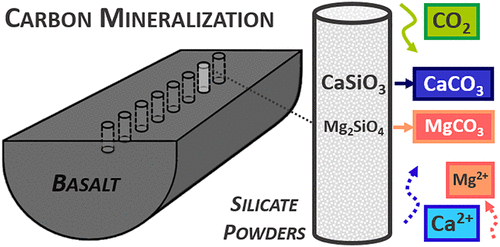当前位置:
X-MOL 学术
›
ACS ES&T Eng.
›
论文详情
Our official English website, www.x-mol.net, welcomes your
feedback! (Note: you will need to create a separate account there.)
Carbon Mineralization in Reactive Silicate Zones
ACS ES&T Engineering ( IF 7.4 ) Pub Date : 2021-05-28 , DOI: 10.1021/acsestengg.1c00066 Anne H. Menefee 1 , Brian R. Ellis 1, 2
ACS ES&T Engineering ( IF 7.4 ) Pub Date : 2021-05-28 , DOI: 10.1021/acsestengg.1c00066 Anne H. Menefee 1 , Brian R. Ellis 1, 2
Affiliation

|
Basalt reservoirs could provide safe and permanent large-scale carbon sinks, which are critical components of negative emission technologies to meet global CO2 emission reduction targets. While the expediency and security of CO2 trapping through mineralization has been proven in the field, the long-term implications of carbonate precipitation on reservoir integrity and fluid transport remain unclear. In this work, we explore carbonate precipitation and alteration patterns induced by CO2 injection in diffusion-limited zones of reactive basalt silicate minerals where the majority of CO2 mineralization is expected to occur. Core flooding experiments were designed to optimize the likelihood of achieving rapid and near-complete carbonation by creating packed beds of reactive mineral powders (olivine and wollastonite) within flood basalt cores. All of the packed beds evidenced conversion of silicates to carbonate minerals with up to 58% carbonation efficiency. Consistent with complementary reactive transport model predictions and prior work on packed beds in static systems, carbonation generally reached a local maximum near the center of the packed beds due to opposing geochemical gradients. Despite equivalent initial amounts of Ca- and Mg-silicate powders, Ca-carbonates were the predominant reaction product as Mg-carbonate precipitation was kinetically limited and in direct competition with more favorable hydration (i.e., serpentinization) of Mg-silicates. While volume expansion associated with carbonation reactions has been held critical to optimizing carbonation efficiency through continual renewal of the reactive surface area, no evidence of reaction-induced fracturing was observed in these tests as precipitates were accommodated by the available pore space and simultaneous dissolution of the packed beds.
中文翻译:

反应性硅酸盐区的碳矿化
玄武岩水库能够提供安全和永久的大型碳汇,这是为满足全球二氧化碳排放的负面技术的重要组成部分2减排目标。而CO的权宜之计和安全2捕集通过矿化已在该领域已经证明,对储层的完整性和流体输送碳酸盐沉淀的长期影响尚不清楚。在这项工作中,我们探索诱导CO碳酸盐沉淀和蚀变模式2中的反应性玄武岩硅酸盐矿物的扩散限制区注射,其中大部分的CO 2矿化有望出现。芯充斥实验旨在优化通过创建溢流玄武岩核内活性矿物粉末(橄榄石和硅灰石)的填充床实现快速,几乎完全碳化的可能性。所有证明硅酸盐转化为具有高达58%的效率碳化碳酸盐矿物填料床。具有互补反应运移模型预测,并在静态系统填充床之前的工作相一致,碳化附近的填充床的中心局部最大值通常达因反对地球化学梯度。尽管等效初始量Ca-和Mg-硅酸盐粉末,钙碳酸盐是主要的反应产物作为镁碳酸盐沉淀动力学限制和在与更有利的水合直接竞争(即,Mg-硅酸盐的蛇纹石化)。虽然与碳化反应相关的体积膨胀已经通过反应表面积的不断更新保持临界优化碳化效率,在这些试验中没有观察到反应诱导的压裂证据沉淀物的可用孔隙空间和的同时溶解容纳填充床。
更新日期:2021-05-28
中文翻译:

反应性硅酸盐区的碳矿化
玄武岩水库能够提供安全和永久的大型碳汇,这是为满足全球二氧化碳排放的负面技术的重要组成部分2减排目标。而CO的权宜之计和安全2捕集通过矿化已在该领域已经证明,对储层的完整性和流体输送碳酸盐沉淀的长期影响尚不清楚。在这项工作中,我们探索诱导CO碳酸盐沉淀和蚀变模式2中的反应性玄武岩硅酸盐矿物的扩散限制区注射,其中大部分的CO 2矿化有望出现。芯充斥实验旨在优化通过创建溢流玄武岩核内活性矿物粉末(橄榄石和硅灰石)的填充床实现快速,几乎完全碳化的可能性。所有证明硅酸盐转化为具有高达58%的效率碳化碳酸盐矿物填料床。具有互补反应运移模型预测,并在静态系统填充床之前的工作相一致,碳化附近的填充床的中心局部最大值通常达因反对地球化学梯度。尽管等效初始量Ca-和Mg-硅酸盐粉末,钙碳酸盐是主要的反应产物作为镁碳酸盐沉淀动力学限制和在与更有利的水合直接竞争(即,Mg-硅酸盐的蛇纹石化)。虽然与碳化反应相关的体积膨胀已经通过反应表面积的不断更新保持临界优化碳化效率,在这些试验中没有观察到反应诱导的压裂证据沉淀物的可用孔隙空间和的同时溶解容纳填充床。











































 京公网安备 11010802027423号
京公网安备 11010802027423号